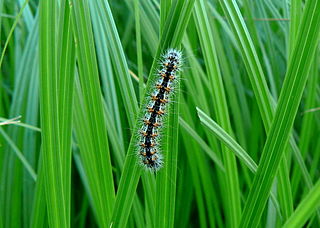Carl Meissner's taxonomic arrangement of Dryandra, now Banksia ser. Dryandra, was published in 1856 as part of his chapter on the Proteaceae in A. P. de Candolle's Prodromus systematis naturalis regni vegetabilis. It replaced the 1830 arrangement of Robert Brown, and remained current until superseded by the 1870 arrangement of George Bentham.

Dryandra ser. Ilicinae is an obsolete series within the former genus Dryandra. It was first published by Carl Meissner in 1856, but was discarded by George Bentham in 1870. It was reinstated with a new circumscription by Alex George in 1996, but was ultimately discarded again in 2007 when Austin Mast and Kevin Thiele sunk Dryandra into Banksia.

Oxicesta is a genus of moths of the family Noctuidae.

Acronicta insularis, the cattail caterpillar or Henry's marsh moth, is a moth of the family Noctuidae. The species was first described by Gottlieb August Wilhelm Herrich-Schäffer in 1868. It is found from coast to coast throughout the United States and southern Canada.

Oxicesta geographica is a moth of the family Noctuidae. It is found in southern Romania, Austria, Hungary, from the former Yugoslavia to northern Greece and Turkey. It has also been reported from Russian Moldavia and Georgia.

Platylabus is a genus of parasitoid wasps belonging to the family Ichneumonidae.






